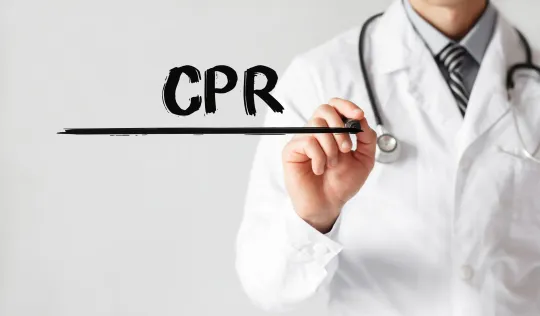There’s one thing that medical dramas and movies, like Grey’s Anatomy or ER, get wrong over and over again, it is CPR. Unfortunately, media depictions of CPR have distorted people’s perceptions of its success rate, and not by just 5% or 10%—try 65%.
In a 2018 study published in the Journal of Emergency Medicine, researchers presented 1,000 survey participants with a variety of scenarios in which patients young and old received CPR both inside and outside of hospital settings. More than half of the participants estimated that CPR was successful in over 75% of the situations presented. The reality is if you experience cardiac arrest outside of a hospital there is only a 1 in 10 chance you will survive according to the most recent data from the National Heart, Lung, and Blood Institute (NHLBI).
When someone’s heart stops, nearly 70% of the time it is when they are at home, which is why more than 1,200 people die each day from cardiac arrest in the U.S. Even when cardiac arrest occurs in a hospital and patients receive CPR within seconds by skilled staff with every piece of equipment at their disposal, less than half survive the initial event. Fewer still survive long enough to be discharged, as few as 20% according to NHLBI data.
And just so we’re all on the same page, cardiac arrest is not the same as a heart attack. In a heart attack, a blood clot blocks an artery and causes heart damage by preventing parts of the heart from receiving oxygen via blood flow. You are conscious and your heart continues to beat. In cardiac arrest, an irregular heartbeat stops the heart from beating and you are unconscious. Cardiac arrest is most commonly caused by prior heart attack damage, congestive heart failure, cardiomyopathy, and atrial fibrillation.
So how did our beliefs get so distorted? More than 70% of the people participating in the survey said they watched television medical dramas regularly. And12% said these shows were a reliable source of health information. Not surprisingly most of the participants also believed if a person was successfully revived that their lives would return to normal. It didn’t occur to the participants that patients who survive cardiac arrest may need long-term care due to neurological damage from their brains being deprived of oxygen.
Clearly, there is a gap in most people’s understanding of CPR. It’s not five minutes of chest compressions and then you walk out of the hospital the next day. We encourage everyone to have conversations about CPR with their doctors if they are going to be able to make truly informed decisions regarding advance directives and POLST forms.
Notes:
Ouellette, L., Puro, A., Wheatherhead, J., Shaheen, M., Chassee, T., Whalen, D., & Jones, J. (2018) Public knowledge and perceptions about cardiopulmonary resuscitation (CPR): Results of a multicenter survey. The American Journal of Emergency Medicine, 36(10), 1900-1901. https://doi.org/10.1016/j.ajem.2018.01.103


